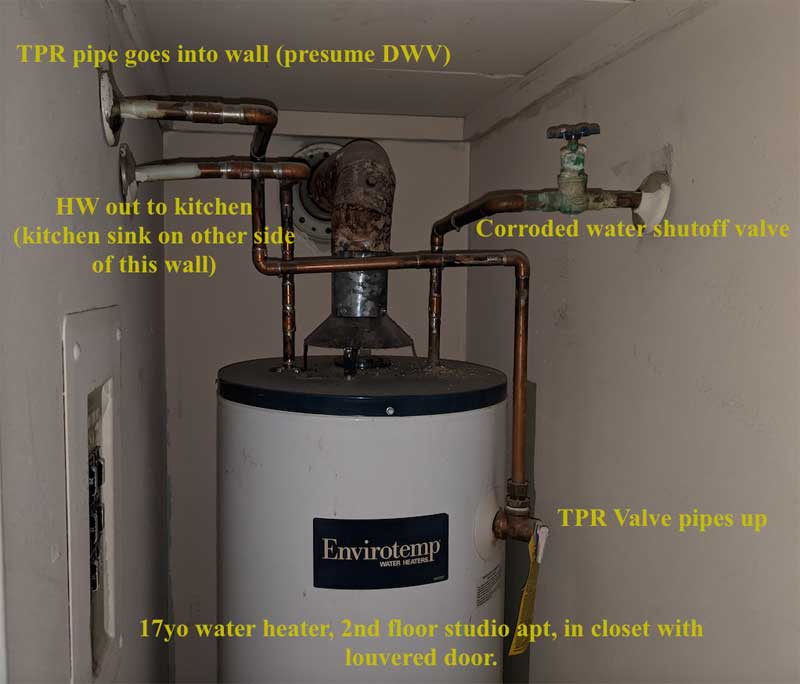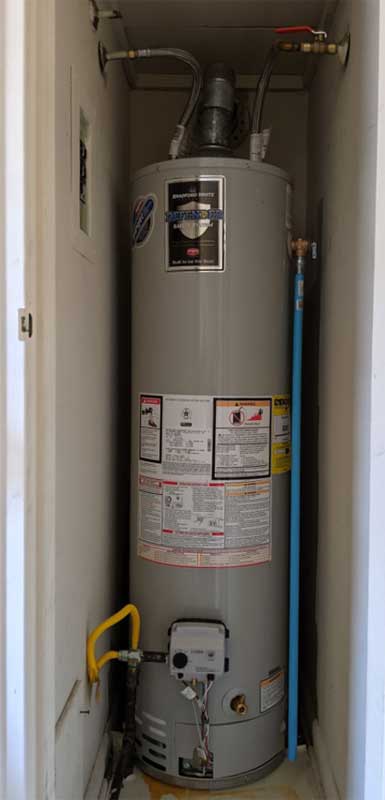citydweller3033
New Member
Hi, here is my situation. I am a renter in a 2nd floor studio apartment. The gas water heater is in a closet, with a louvered door. The WH closet is about 2 feet away from my carpeted living area where I have my sofa and study space.
I'm renting here for 18 more months (third renewal) while I save up for a home purchase.
The hot water is reliable and water pressure is good. The flue looks mostly OK.
I am getting lots of rumbling from the unit and it has been disturbing my work and my sleep (I've been work-from-home since the start of the pandemic.) The noise gets worse in winter, and this winter is worse than last winter. My friends/guests think the noise isn't right, plus it goes on for an hour each time the unit runs. There are loud bangs, like a big piece of sediment clunking around, at least a few times a week, and it shakes the floor. (No pattern as to when that happens either.)
Landlord says nothing is wrong. They got my complaint about the noise, did a visual inspection, watched it run, said nothing is needed and that it's "just old."
I learned more about what I'm looking at and got scared. Found the sticker, the unit was built in 2004 and was only warrantied for 6 years. The city came out and took a look. The city agreed there are some problems.

Here's the concerns.
1) Age of unit + little sign of previous maintenance being done on it. I was worrying about a unit this old holding up much longer.
2) Noise and banging. WH runs about 1 hour after doing dishes, runs about 1 hour after a shower or bath. Constant rumbling, some shaking. Sometimes sounds like a big piece of sediment breaks loose and hits the side of the tank, big loud bang from the unit when that happens. The city wrote a citation for the excessive noise, said the WH is not properly maintained. They said they at a minimum want it to be flushed.
3) Corroded water shut-off valve. The city wrote a citation for this.
4) High likely of damaging my property if it starts to leak or flood. It's just a few feet away from my carpeted living space and furniture.
5) High likelihood of damaging the apartment below. During a normal year I am out-of-town for a week every month. I am also gone for a month around the holidays. No one would be here to call in a leak, until the neighbor's apartment starts to get water.
6) Questionable TPR piping. Goes up, then horizontal, 2 elbows, up again, 2 elbows, then into a DWV which we can not see. City says that this is typical in 60 year old multi-family buildings here. They said the setup is grandfathered even if I get a new WH. No good solutions. This is an interior closet.
- Question: If they insist on keeping the same WH and try to fix it up, should they take out this current TPR and replace it?
- Question: If they were to re-pipe this, not sure if there is any good solution for where to drain it.
- Question: If an installer came and put in a new unit, not sure what they would do.
7) Orange flames in the burner. Some seem high and lapping. I have seen them stay within their confines but there are singe marks on the outer porcelain to the left of the burner access (not sure if I'm calling that by the correct name.)
8) No pan or drain below the unit.
Please give me your thoughts. First my concern was about the age of the unit and the possibility it might start to leak because its old. Then I saw the shut-off valve. Then I got concerned about the burner. Next I read about what TPR valves do and I really don't feel good about how this one looks.
I would like to convince the landlord to buy a new unit. If they insist on repairing this one, the city says they have to flush it, eliminate the noise, and replace the gate valve.
Thanks!
I'm renting here for 18 more months (third renewal) while I save up for a home purchase.
The hot water is reliable and water pressure is good. The flue looks mostly OK.
I am getting lots of rumbling from the unit and it has been disturbing my work and my sleep (I've been work-from-home since the start of the pandemic.) The noise gets worse in winter, and this winter is worse than last winter. My friends/guests think the noise isn't right, plus it goes on for an hour each time the unit runs. There are loud bangs, like a big piece of sediment clunking around, at least a few times a week, and it shakes the floor. (No pattern as to when that happens either.)
Landlord says nothing is wrong. They got my complaint about the noise, did a visual inspection, watched it run, said nothing is needed and that it's "just old."
I learned more about what I'm looking at and got scared. Found the sticker, the unit was built in 2004 and was only warrantied for 6 years. The city came out and took a look. The city agreed there are some problems.

Here's the concerns.
1) Age of unit + little sign of previous maintenance being done on it. I was worrying about a unit this old holding up much longer.
2) Noise and banging. WH runs about 1 hour after doing dishes, runs about 1 hour after a shower or bath. Constant rumbling, some shaking. Sometimes sounds like a big piece of sediment breaks loose and hits the side of the tank, big loud bang from the unit when that happens. The city wrote a citation for the excessive noise, said the WH is not properly maintained. They said they at a minimum want it to be flushed.
3) Corroded water shut-off valve. The city wrote a citation for this.
4) High likely of damaging my property if it starts to leak or flood. It's just a few feet away from my carpeted living space and furniture.
5) High likelihood of damaging the apartment below. During a normal year I am out-of-town for a week every month. I am also gone for a month around the holidays. No one would be here to call in a leak, until the neighbor's apartment starts to get water.
6) Questionable TPR piping. Goes up, then horizontal, 2 elbows, up again, 2 elbows, then into a DWV which we can not see. City says that this is typical in 60 year old multi-family buildings here. They said the setup is grandfathered even if I get a new WH. No good solutions. This is an interior closet.
- Question: If they insist on keeping the same WH and try to fix it up, should they take out this current TPR and replace it?
- Question: If they were to re-pipe this, not sure if there is any good solution for where to drain it.
- Question: If an installer came and put in a new unit, not sure what they would do.
7) Orange flames in the burner. Some seem high and lapping. I have seen them stay within their confines but there are singe marks on the outer porcelain to the left of the burner access (not sure if I'm calling that by the correct name.)
8) No pan or drain below the unit.
Please give me your thoughts. First my concern was about the age of the unit and the possibility it might start to leak because its old. Then I saw the shut-off valve. Then I got concerned about the burner. Next I read about what TPR valves do and I really don't feel good about how this one looks.
I would like to convince the landlord to buy a new unit. If they insist on repairing this one, the city says they have to flush it, eliminate the noise, and replace the gate valve.
Thanks!


